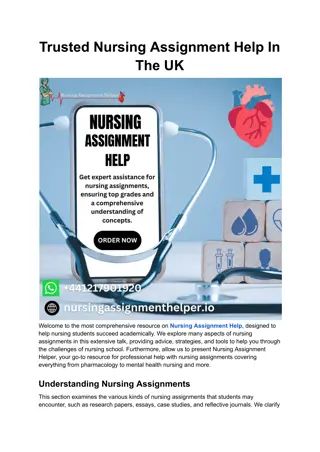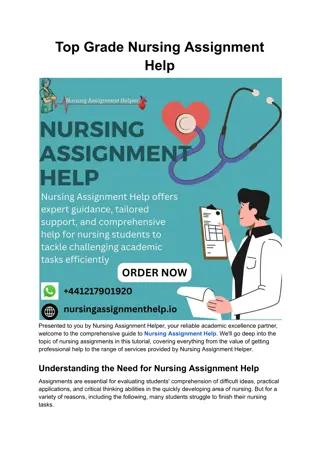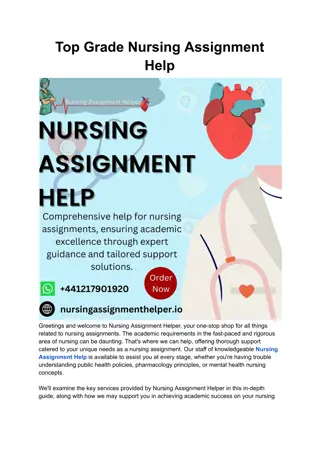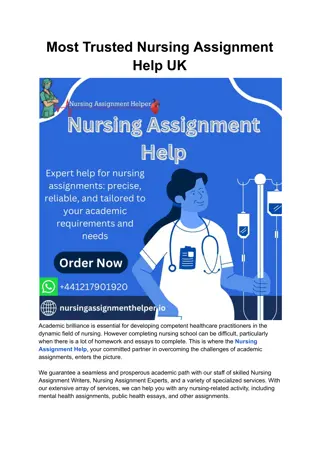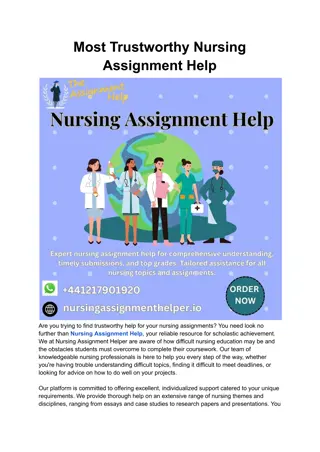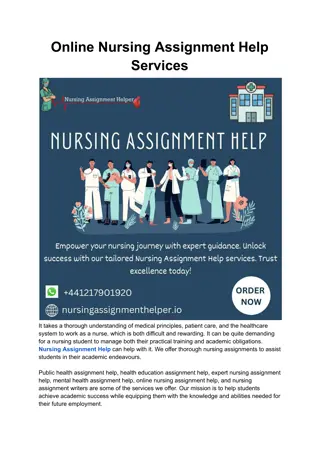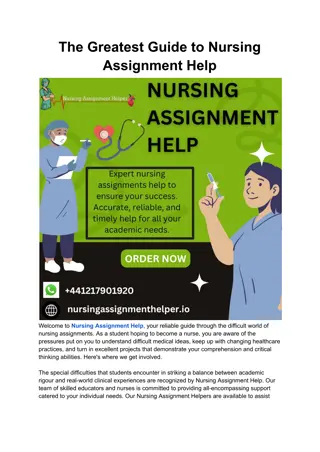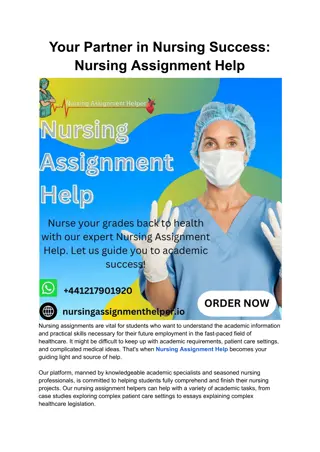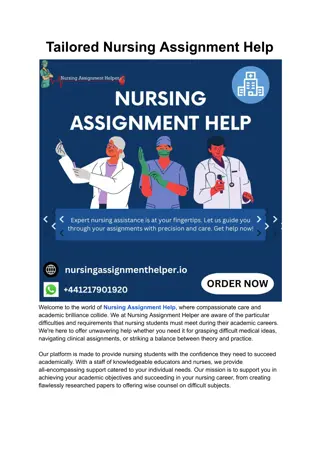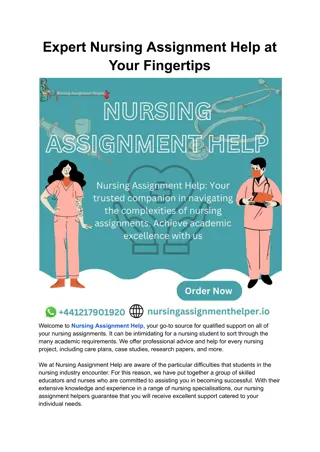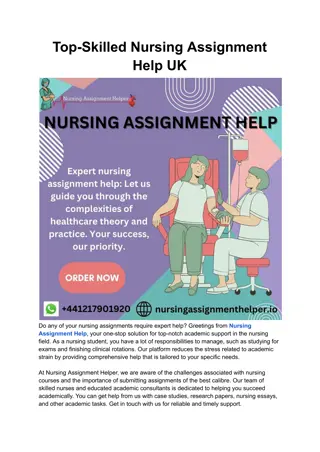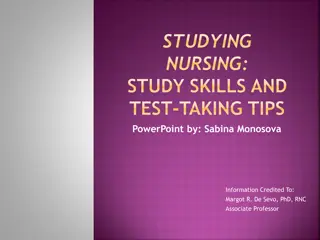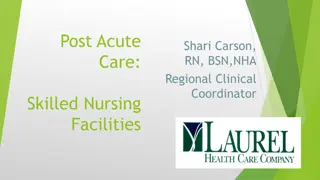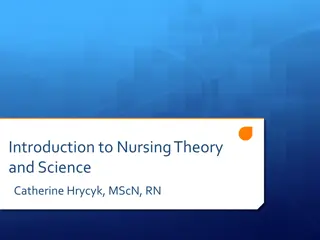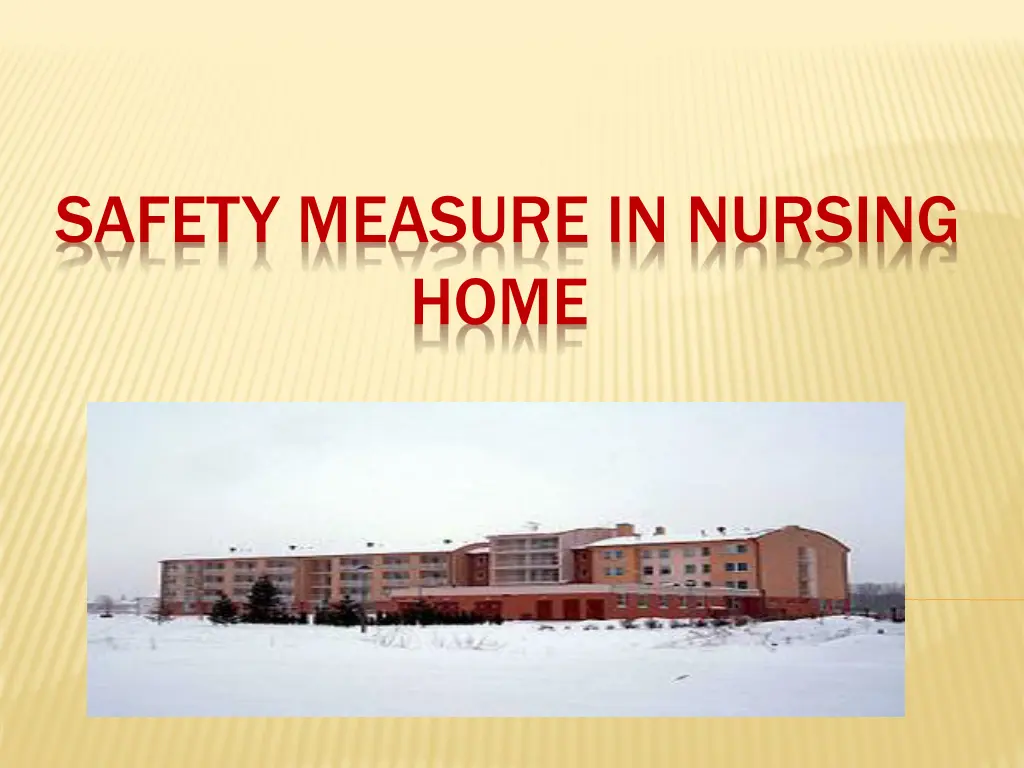
Understanding Safety Measures in Nursing Homes and the Role of Home Care
"Explore the importance of safety measures in nursing homes and the role of home care, including services provided, checklists, and nursing roles. Learn about the definition of nursing homes, common reasons for residing in them, and how they support individuals unable to care for themselves."
Download Presentation

Please find below an Image/Link to download the presentation.
The content on the website is provided AS IS for your information and personal use only. It may not be sold, licensed, or shared on other websites without obtaining consent from the author. If you encounter any issues during the download, it is possible that the publisher has removed the file from their server.
You are allowed to download the files provided on this website for personal or commercial use, subject to the condition that they are used lawfully. All files are the property of their respective owners.
The content on the website is provided AS IS for your information and personal use only. It may not be sold, licensed, or shared on other websites without obtaining consent from the author.
E N D
Presentation Transcript
SAFETY MEASURE IN NURSING HOME https://upload.wikimedia.org/wikipedia/commons/thumb/e/eb/Czciesz_844.jpg/270px-Czciesz_844.jpg
OUTLINE : OUTLINE : Objective Objective Introduction Introduction Definition of nursing home Definition of nursing home the services of nursing home care the services of nursing home care Checklist in nursing home Checklist in nursing home safety measures in nursing home safety measures in nursing home Nursing role of home care Nursing role of home care Summary Summary Conclusions Conclusions Article Article References References
OBJECTIVES OBJECTIVES At the end of this lecture the student will be At the end of this lecture the student will be able to: able to: 1 1- - define nursing home correctly . define nursing home correctly . 2 2- - recognize the service about nursing home recognize the service about nursing home perfectly . perfectly . 3 3- - Discuss Discuss nursing home checklist clearly. nursing home checklist clearly. 4 4- - Describe Describe safety measures in nursing home safety measures in nursing home completely. completely. 5 5- - identify the Nursing role in home care clearly. identify the Nursing role in home care clearly.
Introduction Introduction Most people are able to independently perform Activities of Most people are able to independently perform Activities of daily living such as : daily living such as : ambulating. ambulating. transferring (getting up or changing position), transferring (getting up or changing position), dressing (putting on clothing), dressing (putting on clothing), eating, eating, toileting (using the bathroom), toileting (using the bathroom), hygiene (washing, brushing teeth). hygiene (washing, brushing teeth). Some or all of these tasks may be difficult to perform for the Some or all of these tasks may be difficult to perform for the elderly as they get older either as a part of their overall decline elderly as they get older either as a part of their overall decline or because of an underlying illness. It is important to recognize or because of an underlying illness. It is important to recognize when ADLs become burdensome and when to summon help when ADLs become burdensome and when to summon help from family members or care givers. from family members or care givers.
NURSING HOME -Is a public or private residential facility providing a high level of long-term personal and nursing care for persons (such as the aged or the chronically ill) who are unable to care for themselves properly. -Most nursing homes have nursing aides and skilled nurses on hand 24 hours a day.
THE MOST COMMON REASON FOR LIVING IN A THE MOST COMMON REASON FOR LIVING IN A NURSING HOME NURSING HOME Some nursing homes have special care units for people with serious memory problems such as Alzheimer's disease . Some type of disability with activities of daily living (ADLs) is the most common reason that older people live in nursing homes. Not surprisingly, people living in nursing homes generally have more disability than people living at home. About 25% of nursing-home residents need help with one or two activities of daily living (for example, walking and bathing), and 75% need help with three or more. More than half of residents have incontinence (either bowel or bladder), and more than a third have difficulty with hearing or seeing. In addition to physical problems, mental conditions are common in nursing home residents.
SERVICE IN NURSING HOME 1 1- - Social care Social care 2 2- - Medical care Medical care 3 3- - Home Care Home Care 4 4- - subsistence subsistence 5 5- - Programs and activities Programs and activities cultural activity professional activity entertainment and sports activity
Nursing home checklist Nursing home checklist
Home Safety Tips for elderly Home Safety Tips for elderly - - Due to the growing popularity of the Due to the growing popularity of the home care for seniors, it's important to home care for seniors, it's important to make sure you and your patient are make sure you and your patient are aware of the potential dangers present aware of the potential dangers present in the home for seniors living alone in the home for seniors living alone and prepare accordingly. and prepare accordingly. - - You can help prevent falls and You can help prevent falls and accidents by making changes to unsafe accidents by making changes to unsafe areas in the home with these tips. areas in the home with these tips.
GENERAL HOME SAFETY GENERAL HOME SAFETY The following home safety tips can help keep you and your patient The following home safety tips can help keep you and your patient safe: safe: Keep a fire extinguisher and smoke detector on every floor. Keep a fire extinguisher and smoke detector on every floor. Never smoke when alone or in bed. Never smoke when alone or in bed. Always get up slowly after sitting or lying down. Take your time, and make sure you have Always get up slowly after sitting or lying down. Take your time, and make sure you have your balance. your balance. Wear proper fitting shoes with low heels. Wear proper fitting shoes with low heels. Use a correctly measured walking aid. Use a correctly measured walking aid. Avoid using slippery wax on floors. Avoid using slippery wax on floors. Avoid standing on ladders or chairs. Avoid standing on ladders or chairs. Make sure that all stair cases have good lighting with switches at top and bottom. Make sure that all stair cases have good lighting with switches at top and bottom. 1. 1. 2. 2. 3. 3. 4. 4. 5. 5. 6. 6. 7. 7. 8. 8.
BED ROOM BED ROOM Move furniture with sharp corners away from Move furniture with sharp corners away from the bed in case of falling out of bed. the bed in case of falling out of bed. Wear non Wear non- -skid socks to bed to avoid slipping skid socks to bed to avoid slipping and falling if getting up at night. and falling if getting up at night. Consider the height of the bed and how easy it Consider the height of the bed and how easy it Is to get in and out of bed. Is to get in and out of bed. Install a nightlight. Install a nightlight. Keep a flashlight at the bedside. Keep a flashlight at the bedside. Remove all sources of flame. Remove all sources of flame. Do not smoke in the bedroom. Do not smoke in the bedroom.
BATHROOM SAFETY BATHROOM SAFETY Leave a light on , in your bathroom at night. Leave a light on , in your bathroom at night. Use recommended bath aids, securely installed Use recommended bath aids, securely installed on the walls of the bath/shower stall and on the on the walls of the bath/shower stall and on the sides of the toilet. sides of the toilet. To avoid scalds, turn water heater to To avoid scalds, turn water heater to 120 degrees Fahrenheit or below. degrees Fahrenheit or below. Mark cold and hot tap water clearly. Mark cold and hot tap water clearly. Use door locks that can be opened from both Use door locks that can be opened from both sides. sides. If possible, bath only when help is available. If possible, bath only when help is available. 120
KITCHEN SAFETY KITCHEN SAFETY Keep floors clean and uncluttered. Keep floors clean and uncluttered. Mark "on" and "off" positions on appliances Mark "on" and "off" positions on appliances clearly and with bright colors. clearly and with bright colors. Store sharp knives in a rack. Store sharp knives in a rack. Store heavier objects at waist level. Store heavier objects at waist level. Store hazardous items separate from food. Store hazardous items separate from food. Avoid wearing long, loose clothing when cooking Avoid wearing long, loose clothing when cooking over the stove. over the stove. Make sure food is rotated regularly and check Make sure food is rotated regularly and check expiration dates. expiration dates.
DRUG SAFETY DRUG SAFETY Review your medicines frequently with your doctor or pharmacist Review your medicines frequently with your doctor or pharmacist and when you take new medication. and when you take new medication. Make sure medicines are clearly labeled. Make sure medicines are clearly labeled. Read medicine labels in good light to ensure you have the right Read medicine labels in good light to ensure you have the right medicine and always take the correct dose. medicine and always take the correct dose. Dispose of any old or used medicines. Dispose of any old or used medicines. Never borrow prescription drugs from others. Never borrow prescription drugs from others. Check with your doctor or pharmacist before you mix alcohol and Check with your doctor or pharmacist before you mix alcohol and your drugs. your drugs. Have medication dispensed in a bubble pack or convenient Have medication dispensed in a bubble pack or convenient dispenser. dispenser. Check with your doctor or pharmacist before mixing non Check with your doctor or pharmacist before mixing non- - prescription drugs and prescription drugs. prescription drugs and prescription drugs.
NURSING ROLE OF HOME CARE NURSING ROLE OF HOME CARE
SUMMARY -Nursing home is a place where people who are old or who are unable to take care of themselves and they need special care. -General home safety : bed room , kitchen safety , drug safety. -The nursing role of home care.
Conclusions Conclusions Some nursing homes are set up like a hospital. The staff provides medical care, as well as physical, speech and occupational therapy. There might be a nurses' station on each floor. Other nursing homes try to be more like home. They try to have a neighborhood feel. Often, they don't have a fixed day-to-day schedule, and kitchens might be open to residents. Staff members are encouraged to develop relationships with residents.
REFERENCES REFERENCES 1- http://www.aplaceformom.com/senior-care- resources/articles/home-safety-tips-for-seniors 2-https://medlineplus.gov/nursinghomes.html
ASSESSING GAIT AND BALANCE IMPAIRMENT IN ELDERLY RESIDENTS OF NURSING HOMES The risk of falls in the elderly is an important public health problem. Suitable tests may help detect those at risk of falling. This study determined which balance test for older adults generates the most reliable results in terms of fall risk assessment, based on the number of falls over the last 12 months. [Subjects and Methods] A total of 153 individuals (31 males, 122 females, aged 76.67 8.3 years; median 76.5, range 65 94) were investigated. The subjects were subdivided between fallers (a fall over the last 12 months) and non-fallers (no falls over the last 12 months). All participants were assessed with the following: Barthel Scale, Mini-Mental State Examination, Timed Up and Go, Tinetti Performance-Oriented Mobility Assessment), Berg Balance Test, and OneLegged Stance Test. [Results] Statistically significant differences were detected between fallers and non-fallers in TUG, POMA, BBS, and OLST scores. The number of falls correlated positively with the results for TUG, POMA, and OLST. [Conclusion] TUG and POMA were the most useful screening tests for balance and gait impairment in elderly nursing home residents. Two or more tests should be performed for more precise assessment of the risk of falling.
DONE BY : MAISA ABU HASHEESH DEENA BANI MOSTAFA RAZAN MOHAMMAD SAABNEH




